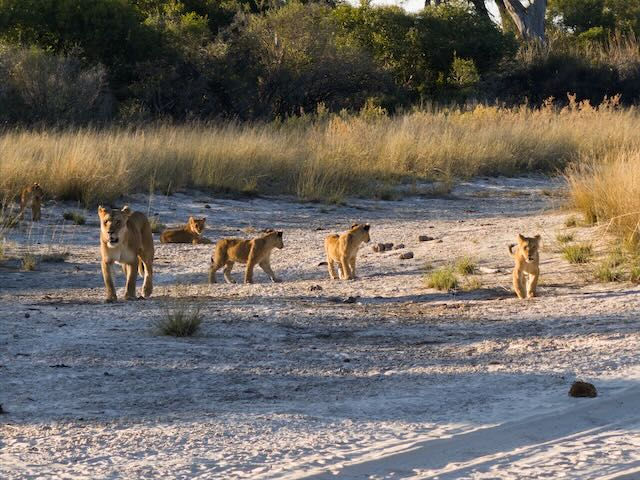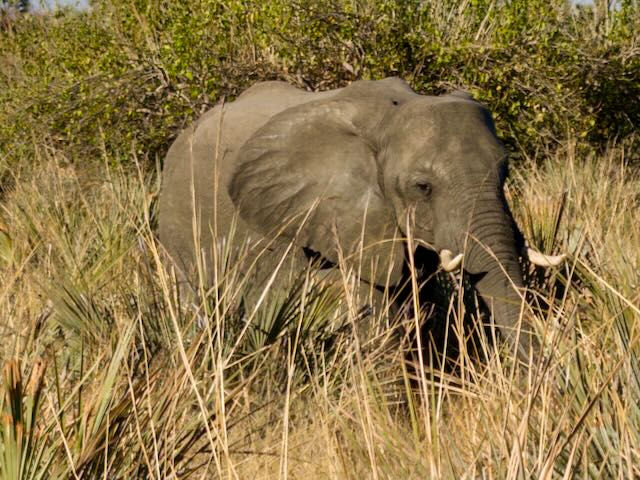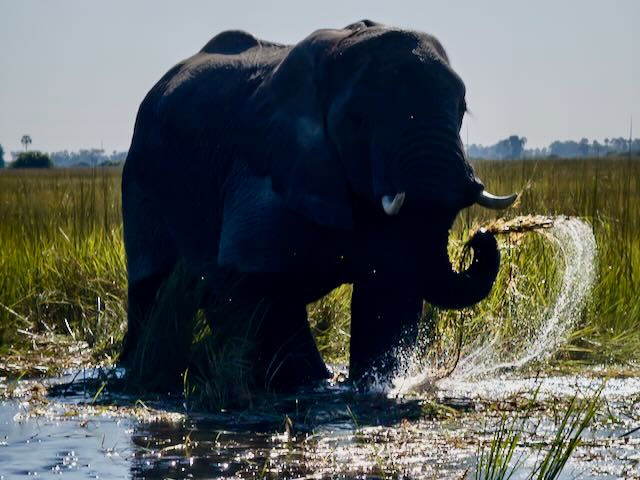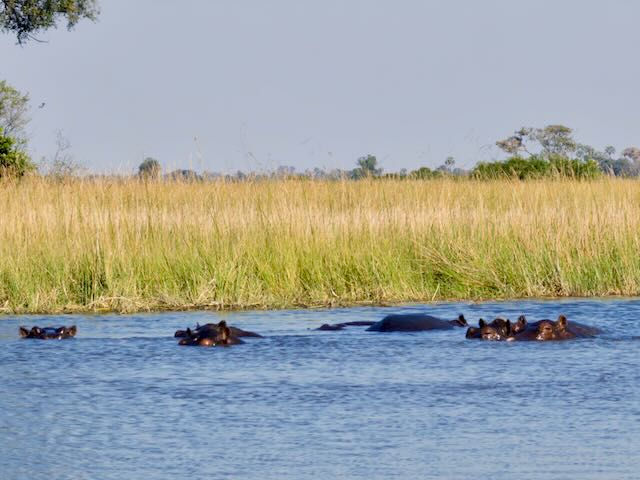Water world - August 5, 2025
- Scott Farnsworth
- Aug 5
- 6 min read
Updated: Aug 11
SUMMARY A great day! We started with a game drive back to see the leopard and her cubs and the now only skeletal remains of the impala had she stashed up in the tree. Also saw more lions. Tubu Tree Camp is in a very wet area of the Okavango delta so we took an amazing boat ride where from 10 feet away we watched elephants pulling up reeds and swishing them in the river to wash away any debris before they ate them. Also watched a large group of hippos doing what hippos do, i.e. just submerging and coming back up for air. On the return trip to the dock we paused while a large herd of elephants crossed the water in front of us. So awesome! After lunch a a bit of down time we got into low canoes called mokoro and we’re poled through tall reeds and water lilies. Sundowners, dinner and bed. - Karen
DETAIL Yesterday we agreed with Stan, our guide, what we’d be doing today. In the morning: in a boat, on the water, and in the afternoon: on a boat, on the water. Not the whole time, of course.
The rest of the day is per the normal structure. It’s our first breakfast here and it’s good. It’s dark, of course, and cold. After breakfast we head out in the safari vehicle. We visit our friend the leopard. She’s gotten her prey (an impala) further up into the tree. Easier to protect. The impala hanging down on one side confirms the animal.
Nearby we hear a lion calling to the family to say where he is. Alerted, we head there, too. The big guy is sitting there in the warmth of the sun. Somehow the lion’s mane always looks big and puffy and clean. I don’t know how they do it.
Following tracks we find more of his family. There’s one of his wives (a big, beautiful female lion) and cubs, six of them. She has to get them from point A to point B and (given that they’re young and cats) it’s a lot like herding kittens. They’ll walk along beside here for a few steps and then decide to pounce on the back of an unsuspecting sibling. Cuteness ensues. Other times a cub will find an irresistible stick that needs chewing. Mom just continues on and knows that the cubs won’t want to get left behind. The lions (the older ones) ignore us, but the youngsters don’t yet know that we’re like a rock or a tree (harmless and not good to eat) and so will watch us with fascination.
We also see elephants (“ellies”). They’re eating, as they always are. They have a lot of body mass to maintain and it takes a lot of food. At one point Stan stops the vehicle, hops out, and picks something up. It’s about the size of a softball and is a ball of fiber. He shows us the nearby palm tree where the tips of the fronds have been chewed off. The ellies, reportedly, chew off the ends and then form them into a ball, in their mouth. This is elephant chewing gum. Oral entertainment. Who knew?
We see a kori bustard, or two. They’re the second heaviest flying bird, weighing 21 kg, or 46 pounds. Their chests have beautiful black and white feathers that end up in fishing lures of fly fisherman, or in the headdress of local tribal heads. It’s not easy for them to fly so we only see this once.
As we get closer to the water we cross one of the log bridges. We’ve seen many but crossed maybe none, so far. When it’s the wet season they’re indispensable, but in the dry season it’s easier and more pleasant to stay on the land, even if you have to motor through a bit of water. Now we’re crossing the bridge and it’s no big deal.
At the dock we lose the safari vehicle and climb into the flat-bottom metal boat. It has a gas motor and a propeller. The water is mostly choked with reeds, but there are channels, created by elephants or hippos, down which we can travel. We see more birds, one completely white, maybe a heron or crane. We see one that’s half black and half white. And on (in?) the water we see a completely black one with oily black feathers that we’re told is called a snake skin eagle.
On the water the motor would hum, happily, and then change tone, which told us the propeller was fouled with reeds. Stan would reverse the engine briefly and then we’d continue on (for another 30 seconds). Rinse and repeat.
We encounter two elephants in the water. They’re pulling up handfuls (well, trunkfuls) of reeds. They’re yummy but the roots are full of sand, not good for the teeth. The ellies swish them forcefully back and forth in the water to get off all of the (most of the… some of the…) sand. They then eat the reeds. Rinse and repeat.
All along the way we see lily pads and lily flowers. Stan explains, in detail, their life cycle and how his grandmother would collect and cook them. We inspect one up close and find a beautiful small frog sunning itself.
We pass an island, made by mushroom farming termites (as they all are), with lots of life on it. Lots of birds (including whistling ducks) and one big crocodile. Every creature is taking in the sun.
The hippos patrol these open waterways and keep them open, but mostly at night. During the day they know the ellies and humans will be out, so they retreat to a big, deep open pool. We see them. Lots of them. Thankfully they keep their distance. I see, but am not quick enough to take a picture of, a big hippo yawn. We have our morning coffee (with amarula - local equivalent to Bailiey's Irish Cream) and biscotti.
On the way back we encounter an enormous group of ellies crossing the water channel. All get across without problem, but the last one, very young and small, gets 1/2 way across and turns back, unsure if it can make it all the way. It tries again and gets across. One of the bigger (biggest) ellies bellows a monstrous roar. We’re not sure if the young one is being chastised for being a weenie baby, or if the young one is being told “get out of the way, I may need to charge this flat metal boat over there”. We’re hoping it’s the former.
In the late afternoon we go out on the water, this time closer to camp. We’re in mokoros. These (traditionally) are hand carved wood. Each comes from one trunk of one tree. A single piece of wood. In the end, the walls and bottom of the boat are an inch or so thick. One boat takes three months to make. Amazing. Now (to conserve trees) they use fiberglass, but it’s formed around a wood mold.
Two passengers per boat with a standing poler. Our powers are Witness and Sisco. We’re on the water (very quiet) for over an hour, gliding over the water, pushing the reeds out of our way. At one point we hear what sounds like a jet plane landing. That? That’s a nearby big herd of Red Leche leaping through the water. Wow, would have been fun to see.
Sundowner, dinner, and to bed. Good day. Big day tomorrow. Another move to our third and last camp (for Karen and myself).
Photos

Delicious breakfast. Cold dining room. Dark out.

Mom loepard with one cub and their meals for a few days, Mr. impala. See leg hanging down.

Papa lion. Quite the roar. And such nice hair.

Mom walking with her six cubs (five visible here). Like herding kittens.

Elephants chew off the ends of palm fronds and roll up their own 'elephant chewing gum'. Fascinating!

An ellie looking for where he left his gum.

The national bird, the Kori Bustard. 46 pounds. The second heaviest bird that actually flies.

Other birds hanging out together in an integrated Botswana.

The oily-looking, black Snake Skin Eagle. It does a lot of it's flying under water, looking for prey.

An ellie swishing the reeds through the water to rinse off othe sandy roots before eating.

Stan giving me the thumbs up and a similar boat in the distance.

A frog in a lily flower in front of a lily pad. Taking in the warmth of the sun.

Whistling ducks, cranes and egrets, and one deadly crocodile.

Many deadly hippos. We're looking at them. They're looking at us. What are they thinking??

A clear (looking) channel. Thank you hippos and elephants.

Tricia communing with her spirit animals.

Crossing the channel. Easier for some than for others.

Us crossing the water in another vehicle.

Ripe palm nuts. Elephants love them. They'll push hard against the tree with their forehead, over and over and all the ripe ones will fall to the ground. The ellies then just pick them up with their trunks and pop them into their mouths. Life is good.

Witness (or is it Sisco?) poling Tricia and Don through the reeds in a mokoro.

Sisco and Witness in their mokoros, the setting sun in the background.

Sundowner time. Tomorrow's another amazing day, we're sure.



Comments